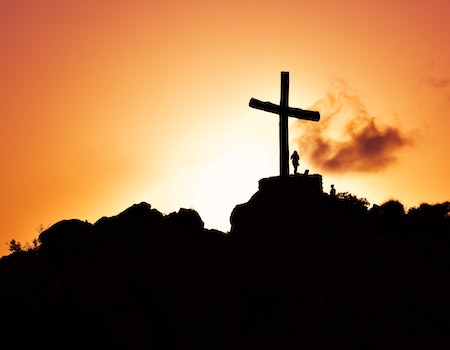Christian Mystery
Stories similar to this that you might like too.
The first thing we encounter on entering the cathedral is a painting of Christ with his hands uplifted in blessing. In front of him stand the Virgin Mary and St John the Baptist, and behind them are twelve disciples holding their crucifixes.
The two saints are shown in deep blue robes embroidered with gold stars, which is why they are sometimes called Blue Saints. Their faces have been painted over to form the same image; it would be very hard to make out their features now if you did not know who they were meant to be.
Behind Christ, there are three paintings showing different miracles performed by him: he has turned water into wine at a wedding party (the painting shows only the heads of the people standing around him); he has healed a man who had no arms or legs (the armless man can be seen holding his cloak in front of himself as Christ reaches out from the altar to touch him), and he has raised Lazarus from death (Lazarus appears walking down from off the edge of the panel).
On either side of each miracle are depictions of Christ praying, one kneeling and one standing. All three pictures show Christ looking straight forward towards heaven, but with his face turned away slightly so that all can see it.
This is because the paintings are meant to be a kind of Christian mystery: we can never be sure what our God looks like, but this is how Christians believe it must look when he is blessing us. It is an idea that comes from Jewish tradition as well: Moses’ face was always veiled because God is beyond human eyesight.
In the Bible, it is written that Jesus said to his mother after his resurrection, “Woman, behold thy son!” – which means that he was talking to her since she could have been the only person who saw him risen again. But then Jesus says, “Behold thy mother”, which is to say to everyone else.
There is more symbolism in the paintings. One is the Last Supper, where Jesus is joined by his disciples for the Passover meal. There are thirteen people depicted, but only twelve are named; Judas Iscariot, the traitor who has betrayed Jesus to the Romans, is absent.
This is a reminder that we cannot trust those outside the group to be loyal to Christ. It is also a reminder of the importance of loyalty within the group: Jesus knows his followers better than anyone else, and he will accept them even if others do not.
In the center of the cathedral stands another large painting of the Crucifixion. The cross itself is made up of many crosses, each one reaching from one side to the other. The cross is a sign of martyrdom because it shows that Christ died to save us all.
His body lies flat on the ground and his head rests upon the lap of the Virgin Mary. Above them is the halo that all saints wear and which is intended to show that he was chosen by God in advance. The cross has four nails hammered into it.
Three nails are driven through Jesus’ hands, while the fourth goes right through his feet. The artist has painted over the blood so it runs away down the sides of the cross. This is meant to remind us that Jesus died not for some great deed but simply because he was innocent.
He took on himself the punishment we deserved so that we should not go to hell but have eternal life instead. If someone were to draw a picture of the crucifixion, they would normally include Jesus in the middle under one nail – but not in this painting. The artist has left him out of the center because he is already in paradise where no suffering exists anymore.
The story of Easter is told in a stained-glass window opposite the main altar. The central part is about Jesus rising from death; the rest tells how his friends went to tell the apostles what had happened. They are all shown in white, except for Mary Magdalene who is black.
She is portrayed as a harlot who has become a saint. This is to emphasize that the real point of the resurrection is salvation rather than just personal reward. Mary has come back from death to be at Jesus’ side, and to be a witness to his power. When she sees him rise she falls down in tears, but then lifts her head and goes out to spread the news of his victory to everyone else.
There are three more paintings in the cathedral showing the Ascension. These are set high up on the wall, so the light comes in shining through them in a way that makes them glow. The topmost shows Jesus ascending to heaven in front of two angels, both wearing halos.
Behind them is a landscape, which shows that he has reached the promised land of peace. Below him are four apostles and below them two women with children, whom he has brought with him. At the bottom of the picture is a dove which represents his presence among us still.
Beneath it is a second picture of the same scene, and this time the landscape is upside down and there is a cross in the middle of it.
Below the central picture is one showing Jesus walking along the sea of Galilee to meet his disciples who have gathered in boats at his bidding. The disciples are in white robes, but their faces are hidden, leaving only their eyes uncovered so that they can recognize him even when he is far off.
Their clothes reflect their status in society: Simon Peter’s tunic is green and gold, indicating that he is now an important leader; Nathanael wears a blue cloak, which indicates he is an educated man; James the son of Alphaeus, who was a rich man, has red clothes and a yellow cloak; and John wears purple. These are all symbols of rank that the artists chose to represent in these paintings.
The last panel in the cathedral shows the Ascension itself. Again he has taken flight and the landscape is upside down, meaning that he has entered another world. There are seven scenes below it showing events happening around him, including a gathering of people on the shore; a group of angels singing in the sky; and a group of shepherds watching over their flocks.
These scenes are supposed to symbolize that Jesus has returned to his own world after having been away to help others.
One interesting aspect of these paintings is that none of them actually depict Jesus in his fullness. None of the artists could really capture him on canvas because he was so divine.
Instead, they use symbolic images: Mary’s tears mean that he is near; Simon Peter’s cloak means that he is now a powerful leader; John’s purple clothes show he has gone into the desert; Nathanael’s red clothes suggest he has traveled widely; and the angels signify his return to heaven.
All this symbolism is very helpful in understanding Easter because the whole thing hinges on his divinity and his mission to bring us to live in the afterlife. As such, the Easter story is much more profound than the Christmas story.
We can see how different it is from most stories because it has no beginning or end; it merely describes his arrival on Earth and his departure, which means that it has always been part of our lives. This explains why Christians have felt able to change many of the details surrounding it, and adapt it to suit their needs over time.
For example, the names of the people in the paintings may be changed, and they will often have been added later by a different painter. Also, they are usually placed at random in the composition and don’t follow any particular rules about perspective. But it is also clear that some of the details do follow a certain pattern.
For instance, every scene has something happening on either side of Jesus; he is surrounded by crowds, and there are two or more figures involved in each event. He does not stand alone against his enemies. The whole thing feels very much like a theatrical production.
This story of the Resurrection of Christ is one that we have heard again and again during our time together. Each time I hear it my heart begins to fill with joy because it gives me hope that there is another life waiting for all of us when our earthly journey ends.
That is why I wanted to share it with you today because the story has helped to make me what I am. It is the reason that I feel so close to the Risen Lord – and it is the same reason why millions of others do too.
The End


